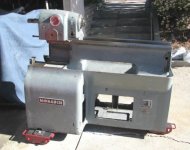No reason why not, but I think I would have some sort of screw down leveler feet to stabilize it and screw them up when your going to roll it.
Exactly that. There's a thread on mine from few years ago. I HAVE 2,000 lb per-each casters. They are waaaay too tall for a safe 10EE roll-about, cannot recommend them even were it not. Most caster failures are from side-loads.
Machinery skates are what one wants, and
'caster', as-in self-align under force, they do not.
Have to be 'aimed' before moving.
I bored out two of the kinematic cored holes to take 3/4" bolts. Moved the HS end rear one slightly to gain more space vis a vis the motor mounting plate.
Northern Tool 3300 lb per-each 8-bearing skates were drilled as well. A linen-bakelite filler plate drilled to match was set into the channel of each. 3/4" bolt, head down, rising through the centre of each skate.
Three nuts and a few more washers decide whether the weight is on the skates or if the bolt-head pushes against steel Scotch-block plates I can place between the skate's axles. Those insure it dasn't go walkabout, even if NOT jacked-up.
I 'aim' the skates by taking the strain off with an automotive trolley jack under the 10EE base. No need to waste space on a pallet jack I don't have room to swing, OR store.
When working on the 10EE's innards or wotever, I 'crab' it out into an open space with all three set at about 30 to 50 degrees off the 10EE's long-axis.
Once out there, I most-often set each of the three skate's axis to the minds-eye circumference of a circle and can then pivot the 10EE in its own length.
Skates were purchased. I stock them anyway. Also their 4400 lb urethane-roller cousins. Had my fill of loose pipe-rollers long ago.
No cutting or welding was required, no steel bought but three 3/4" bolts, some nuts and washers.
With skates in-hand, all it wanted was just three holes, one center of each steel skate, three more in the reinforced phenolic filler (makes 'aiming' easier), opening-up two of the three already-cored kinematic holes and drilling one outright to pass larger bolts.
The cored holes will pass 5/8" without that but I wanted the holes cylindrical, not conical, so as to avoid the bolts being able to tilt.
We've actually had a couple of Earthquakes here. No problems, but I AM glad I went up to 3/4" bolts rather than 5/8" drop-in size.
Bill



